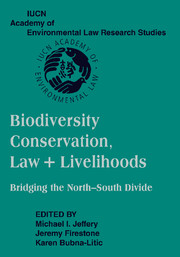 Biodiversity Conservation, Law and Livelihoods: Bridging the North-South Divide
Biodiversity Conservation, Law and Livelihoods: Bridging the North-South Divide Published online by Cambridge University Press: 31 July 2009
The term “bioprospecting” is a relatively new one, and as yet there is no consensus on its precise legal meaning. But what it appears to cover are the range of activities associated with searching for, discovering, and researching unique biodiversity for potential commercial applications. The Antarctic region, which we will take to be the entire area south of the Antarctic Convergence, is a region containing such uniqueness. Bioprospecting has already been underway in the Antarctic for some years.
Bioprospecting in the Antarctic presents the familiar generic challenges associated with the activity anywhere. It also, however, carries with it additional and particular challenges because of the region's contested and unresolved territorial sovereignty situation, which is managed through a delicate (and itself periodically contested) form of international governance through the Antarctic Treaty System.
The principle achievements of the Antarctic Treaty System include: practical demilitarisation of the region, ensuring freedom of scientific investigation (including free availability of scientific observations and results) and the establishment of science as the currency of national presence, containing the territorial sovereignty problems, safeguarding the environment, and establishing activity-specific responses to issues (sealing, marine harvesting, minerals activities, and [currently] tourism) as they arise.
To save this book to your Kindle, first ensure [email protected] is added to your Approved Personal Document E-mail List under your Personal Document Settings on the Manage Your Content and Devices page of your Amazon account. Then enter the ‘name’ part of your Kindle email address below. Find out more about saving to your Kindle.
Note you can select to save to either the @free.kindle.com or @kindle.com variations. ‘@free.kindle.com’ emails are free but can only be saved to your device when it is connected to wi-fi. ‘@kindle.com’ emails can be delivered even when you are not connected to wi-fi, but note that service fees apply.
Find out more about the Kindle Personal Document Service.
To save content items to your account, please confirm that you agree to abide by our usage policies. If this is the first time you use this feature, you will be asked to authorise Cambridge Core to connect with your account. Find out more about saving content to Dropbox.
To save content items to your account, please confirm that you agree to abide by our usage policies. If this is the first time you use this feature, you will be asked to authorise Cambridge Core to connect with your account. Find out more about saving content to Google Drive.